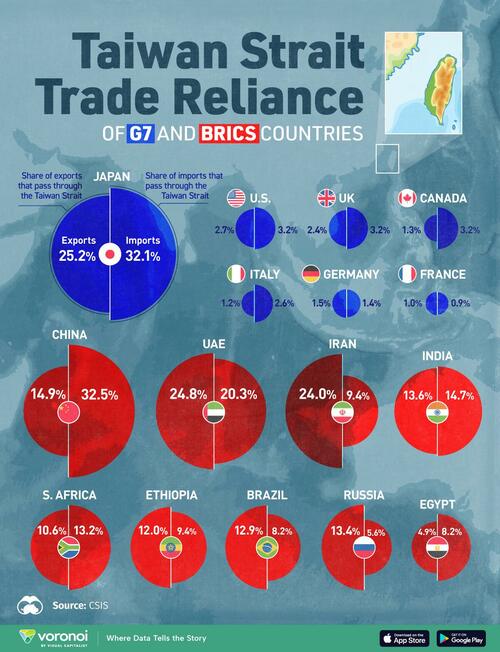
With China continuing to conduct military drills near Taiwan, as well as recently reaffirming that use of force will always remain an option to bring Taiwan under its control, concerns have grown over how potential Chinese actions in the region could impact global trade through the Taiwan Strait.
This graphic, via Visual Capitalist's Kayla Zhu, visualizes the share of exports and imports that move through the Taiwan Strait, broken down by the G7 and BRICS countries.
The data comes from the Center for Strategic and International Studies (CSIS) and is updated as of October 2024.
Which Countries are Most Reliant on the Taiwan Strait?
Below, we show the share of exports and imports that transit through the Taiwan Strait by both G7 and BRICS countries.
BRICS countries overall are more exposed to disruptions to trade routes in the Taiwan Strait, specifically China, the United Arab Emirates, and Iran. The latter two have 24% or more of its exports pass through the strait.
China and Japan are the most reliant on the Taiwan Strait for both imports and exports, specifically imports. Almost a third of both countries’ imports pass through the Taiwan Strait.
According to CSIS, over 95% of Japan’s crude oil comes from a select group of Middle Eastern countries, much of which is transported through the Taiwan Strait, making this route integral to Japan’s energy security.
As for China, while CSIS estimates that 15% of its exports pass through this waterway—a relatively lower share than other countries—the total value of these exports is still over $551 billion.
The Taiwan Strait is not only essential for China’s international trade but also plays a key role in its domestic commerce. More than half of the voyages through the strait connect the numerous ports along China’s eastern seaboard, according to CSIS.
Aside from Japan, G7 countries generally have much lower reliance on the Taiwan Strait. The U.S., UK, Canada, Italy, Germany, and France each have single-digit percentages for imports and exports through the strait.
The Taiwan Strait has been the site of multiple major crises between China and Taiwan since the 1950s, many of which involved military confrontations such as artillery bombardments, missile tests, and naval deployments.
To learn more about how G7 and BRICS stack up agains eachother in other areas, check out this graphic that compares G7 and BRICS countries by GDP.
With China continuing to conduct military drills near Taiwan, as well as recently reaffirming that use of force will always remain an option to bring Taiwan under its control, concerns have grown over how potential Chinese actions in the region could impact global trade through the Taiwan Strait.
This graphic, via Visual Capitalist’s Kayla Zhu, visualizes the share of exports and imports that move through the Taiwan Strait, broken down by the G7 and BRICS countries.
The data comes from the Center for Strategic and International Studies (CSIS) and is updated as of October 2024.
Which Countries are Most Reliant on the Taiwan Strait?
Below, we show the share of exports and imports that transit through the Taiwan Strait by both G7 and BRICS countries.
BRICS countries overall are more exposed to disruptions to trade routes in the Taiwan Strait, specifically China, the United Arab Emirates, and Iran. The latter two have 24% or more of its exports pass through the strait.
China and Japan are the most reliant on the Taiwan Strait for both imports and exports, specifically imports. Almost a third of both countries’ imports pass through the Taiwan Strait.
According to CSIS, over 95% of Japan’s crude oil comes from a select group of Middle Eastern countries, much of which is transported through the Taiwan Strait, making this route integral to Japan’s energy security.
As for China, while CSIS estimates that 15% of its exports pass through this waterway—a relatively lower share than other countries—the total value of these exports is still over $551 billion.
The Taiwan Strait is not only essential for China’s international trade but also plays a key role in its domestic commerce. More than half of the voyages through the strait connect the numerous ports along China’s eastern seaboard, according to CSIS.
Aside from Japan, G7 countries generally have much lower reliance on the Taiwan Strait. The U.S., UK, Canada, Italy, Germany, and France each have single-digit percentages for imports and exports through the strait.
The Taiwan Strait has been the site of multiple major crises between China and Taiwan since the 1950s, many of which involved military confrontations such as artillery bombardments, missile tests, and naval deployments.
To learn more about how G7 and BRICS stack up agains eachother in other areas, check out this graphic that compares G7 and BRICS countries by GDP.
Loading…






